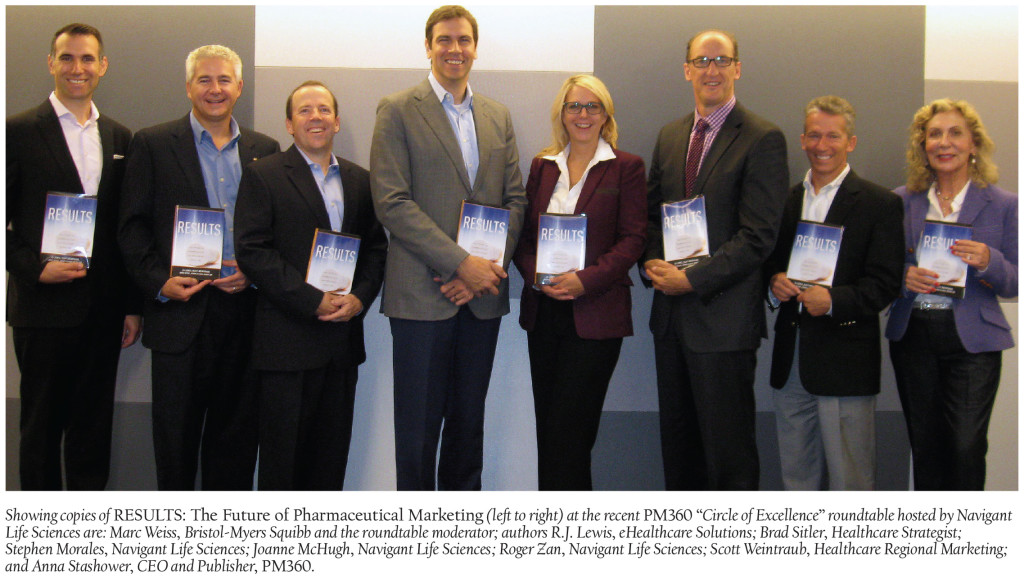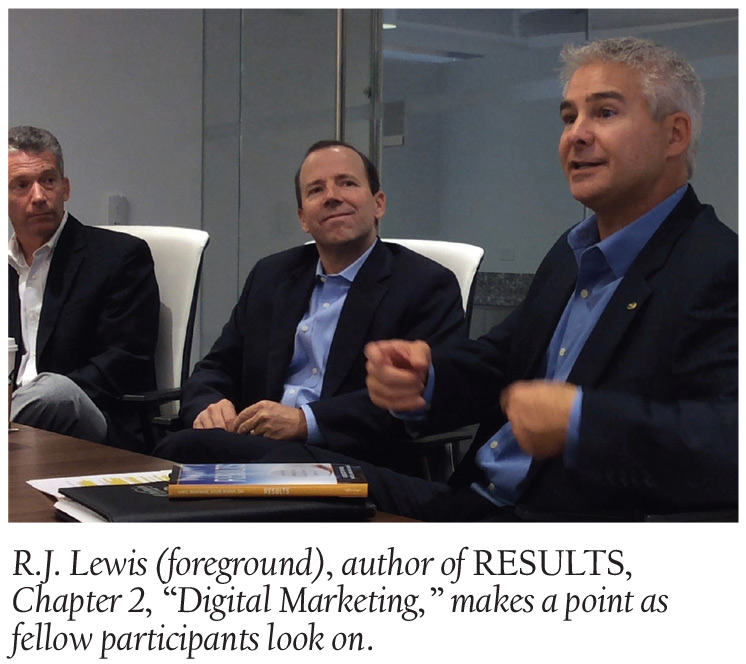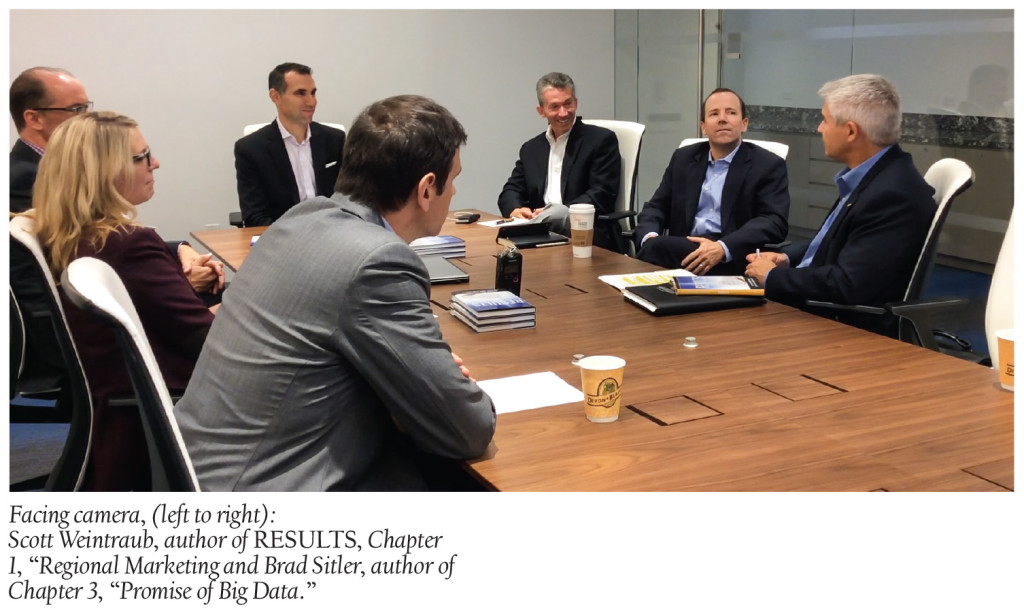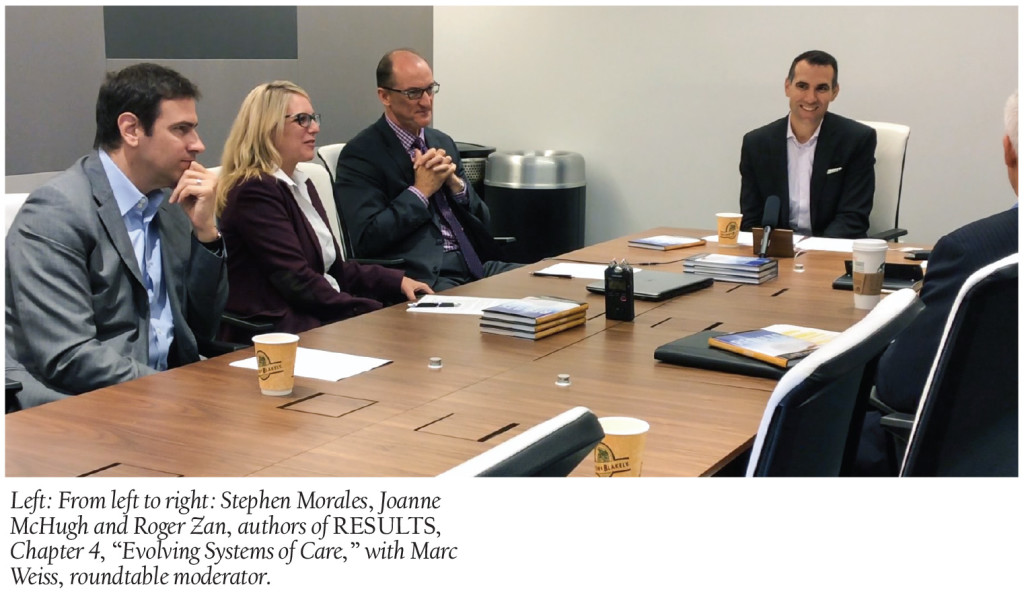The ground is moving quickly beneath the feet of today’s pharmaceutical marketers as healthcare, as we’ve known it, undergoes seismic disruptive changes. But, as this ground shifts, both opportunities and challenges will present themselves to marketers.
In a recent roundtable discussion of the book, RESULTS: The Future of Pharmaceutical and Healthcare Marketing (Advantage, 2015), authors—R.J. Lewis, Founder and CEO, eHealthcare Solutions; Scott Weintraub, Founding Principal, Healthcare Regional Marketing; Brad Sitler, Healthcare Strategist; Joanne McHugh, Managing Director, Navigant Life Sciences; Roger Zan, Managing Director, Navigant Life Sciences; and Stephen Morales, Director, Navigant Life Sciences—dive deep into what marketers need to know to stay relevant and profitable in today’s environment.
Moderated by Marc Weiss, Director, Multi-Channel Marketing – Digital Hub Lead at Bristol-Myers Squibb, the authors gathered and discussed the trends shaping the future, outlined in each chapter of the book: The need to focus on regional marketing; the urgency to both personalize and track digital messaging; the skills and tools needed to leverage Big Data; and the necessity for partnerships within the evolving systems of healthcare. PM360 presents quotes from RESULTS followed by pointed excerpts from the day-long discussion.
On Regional Marketing…Fine-Tuning Your Messaging
“At its core, healthcare is a local business. Different needs in different regions significantly influence sales. How can a pharmaceutical company sort through hundreds of variables for insights into how to reach those regions effectively and efficiently?”
Marc Weiss: Scott, as the champion for the book—what was your motivation for taking on such an important topic?
Scott Weintraub: With all of the change occurring in healthcare, I found it very frustrating that many pharmaceutical marketers are still thinking as they did 10 years ago. Marketers need to think differently—they need to think about ways to make the product and message more relevant to the HCP, the patient and the provider (hospital) systems. “One-size-fits-all” is not going to work anymore.
Marc Weiss: Scott, you wrote the chapter on using regional marketing, rather than mass marketing. Talk about what a typical marketing analysis will tell a brand team?
Imagine you are a pharmaceutical brand director. You may be frustrated by the variation in your product’s performance when comparing one market to another. For example, maybe in Dallas you have a 10 share and in Kansas City, you have a 40 share. Dallas (and any market like Dallas) can be very frustrating. Via regional marketing analysis, you can employ advanced mathematical processes to analyze the data and can see the specific local performance drivers market by market and then via a clustering algorithm, combine like markets that reveal the biggest driver for each and every market (and group of markets).
Marc Weiss: Scott, this sounds great, but is it scalable?
Great question. While I was the brand director at Pfizer, Brooklyn was the number one sales district. The Brooklyn district manager needed tools translated into Russian as Brooklyn had many Russian customers. You know he is right, but he is the only person in the country who needs this—not scalable. Instead you tell him, the second biggest driver in your market is having specialists who influence primary care, let’s focus on this (as 30 plus other markets can use these type of tools).
Compare this to San Antonio: 25 plus markets exist in which Hispanic translation makes sense. It can’t be individual—it has to be scalable. Because if you are a brand director and I say we can divide the country into four virtual regions, you should treat them slightly differently—that makes sense. But if I say you have 116 districts and we need 116 different marketing plans, there is no capacity for that.
R.J. Lewis: Scott, I know some of the value with regional marketing is the link between marketing and sales—you create data that empowers the sales team. How are you dealing with rep access as 50% of doctors don’t see reps anymore?
Scott Weintraub: Great question. In the specialist to primary care example above, we can create non-personal and digital communications—emails that are sent from the specialist to every primary care doctor that knows that specialist. The doctor receiving the email is more likely to open it because it is not a promotional program from a pharma company. That’s one way to get to the doctor, not through physical access, but through message access.
We implemented another program working with IDNs. We employ a program in which physicians in a particular hospital use radio to market and record a public service announcement. For instance, “Do you or someone you love have high blood pressure? I am Dr. Scott Weintraub, a cardiologist here in New York. As a cardiologist, I understand the importance of taking your blood pressure medicine” …and so on. This message saves lives. So physical access may be cut off, but the doctors are participating in other partnership programs, in this case, that are eradicating a disease.
On Digital Marketing…Digging Deeper Into Data
“One-size-fits-all messaging, delivered via mass media, is simply no longer relevant and only contributes to the noise.”
Marc Weiss: R.J., you wrote a chapter on digital marketing, an interesting area that’s become a focus for the pharmaceutical industry. What are some of the biggest trends you are seeing?
R.J. Lewis: Our customers have multiple customer constituents of their own, such as physicians, HCPs, patients, caregivers, payers, etc. As such, we tend to look at the world through all of these lenses. For physician marketing, one major marketing trend is authenticating physician across devices. That is, documenting and verifying who they say they are, which enables specific list-match targeting, empowering a brand to reach only the prescribers they desire to reach with their messaging.
This has long been available through email, but it’s now extending in scalable volumes into banner and content delivery as well. We can target specific doctors with specific messaging to achieve the goal of reaching them at the right time with the right message.
Another physician trend is the evolution of programmatic ad exchanges custom-developed for physician/HCP reach. Programmatic is “machine to machine” buying which enables the marketer to directly buy access to their specific audiences with a few clicks of the mouse. This may really disrupt the media and planning side of the ad agency world. When executing a media plan is as simple as executing an online buy order for an equity/stock trade, suddenly the black box of media planning and buying planning becomes really transparent and easy.
Additionally, and also expanding to the patient and caregiver as well, we see increasing use of geo-medical data and propensity modeling to target digital advertising more effectively. For example, using IMS data to understand which zip codes have the highest incidence of a particular diagnosis, and dynamically adjusting targeting as the data changes. The end message for the brand manager: We can reach 62% of the type 2 diabetic patients, for example, only by targeting 41% of the country. Targeting niche populations based on propensity modeling and granular geographic distributions increases both the efficiency and effectiveness of the digital media spend.
Marc Weiss: We’re shifting from targeting contextually, the traditional approach, to targeting based on audiences. How is that playing out in digital marketing and where it is headed?
R.J. Lewis: Contextual targeting is simply putting a diabetes advertisement on a diabetes webpage, or placing an ad for brand X on the specific brand X drug information page on a website such as drugs.com for example. But, building a profile of a person based on the information they are consuming, other attributions that may have been gathered from them through user submitted profiles or simply their interactions, allows you to better segment defined populations. When you create a persona around the type of person you want to reach, the context in which you reach them, while it still matters, becomes less important. The timing of the message becomes even more important. So for example, if you can surmise they are a newly diagnosed patient, or a patient who is about to visit their doctor, your messaging can and should change accordingly—regardless of the context in which you message them.
Where this gets really appealing, and when significant cost efficiencies are realized on media, is when you actually step out of the medical context and start to target those providers or those patient populations on Yahoo, CNN or elsewhere. So you’re targeting the person, not the contextual environment. When modifying the messaging to show how our product compares to the one you probably use, or offering a coupon for a discount on our product, the role of the marketer starts to morph into that of a helpful customer service role, which provides support and value.
On Big Data…And Partnering for Success
“The challenge in this age of Big Data is how to rally the expanding databases for potentially huge benefits. How can we sift through those mountains of data for improved sales? If we can make sense of it all, we can learn the right marketing actions.”
Marc Weiss: Brad, how are pharmaceutical and healthcare companies using Big Data today and how could it be leveraged in the future?
Brad Sitler: Pharma uses data in very traditional ways, so it starts with changing the definition of Big Data to include electronic health records data, combined with claims data, combined with fitness and activity track data, combined with mobile health app data, combined with patient support and patient adherence program data. When combining all that data, you get a much richer view of a consumer or of a patient—not just in a clinical setting, but also in how each lives their life. That’s important to drive patient behavior, which is what we need to do if you look at the cost of care around chronic disease.
We need to support patients in their behavior change and that data gives us the insights to do that. For instance what patient support do they need, what interventions are working—and it’s even more granular than that, you might look at one type of particular mobile app or patient support intervention and say, “Well that doesn’t work.” But looking deeper into the data, it does work—but only for a very small segment of patients. You would want to keep leveraging that intervention or combination of interventions for that particular patient segment. But you want to leverage other combinations of patients for programs other patients use and that rich, Big Data allows you insight to decide—to see what works for some patients and what works for other patients.
Marc Weiss: It seems almost daunting if you are not doing it right now. How do you approach that?
Brad Sitler: It could be perceived as daunting. The first thing is the data. You need to find ways to get access to this much richer set of data. So partner with IDNs, get access to EMR data. You need to get psychosocial behavioral data assets from companies like Epsilon. You need to get a third party to host that data and combine it. Ideally you would want to go to a payer and get the claims data, so you have a 360-degree view of the patient from a claims perspective.
The last piece: If all of your interventions rely upon the third party you hired to do all the measurement and make it work for you—which is fantastic—you don’t ever have a holistic context. That particular patient or those groups of patients, for example, unknown to you, might have also enrolled in a patient support program run out of the primary care office, or the specialist office. Or maybe that patient was also enrolled, unbeknownst to you, on your online patient support group. You need to get all of the touchpoints with your patient together and sent to a repository.
Joanne McHugh: And social listening is an important part of this. Some of the big pharma companies are experimenting with partners like PatientsLikeMe to fuel the R&D process—which is very innovative. It’s going to help them focus more specifically on future needs. They’re also partnering with Practice Fusion, an EMR system, to do some longitudinal patient record mining to understand how to identify the most high-risk asthma patients, for example. You need to enable the HCP to identify those patients and then place them into programs that would actually help to minimize any acute events. Some of the big players have built the capabilities to execute that. That wasn’t true a few years ago, but a lot of pharma companies have tested the waters enough: We’re starting to see some models that are building some success.
On the Evolving Systems of Care… Is Pharma Ready?
“Pharmaceutical manufacturers have to understand this evolving market and determine how to best work with these big systems of care.”
Marc Weiss: We are looking into evolving healthcare systems. Joanne, can you tell us about these provider systems and what role pharma would play?
Joanne McHugh: Provider systems are moving toward various accountable care models. Systems are focused on chronic, acute and preventative care, and managing episodes of care—this is an evolution. Systems have varying levels of sophistication at this time—as does pharma. Some pharma organizations have progressed further in their own evolution and are able to adapt and react to what their new customers look like, who they are, and how they make their decisions.
The pharma evolution generally has three phases. The first phase is simply a basic understanding—what is an IDN, what are ACOs and how do they make decisions? The second phase: How do I engage with these stakeholders, who are the people that I need to engage with, and what are the messages I would send them? The third phase: Partnership. After gaining an understanding of these organizations and learning how to interact with them, what value-added services can pharma bring in? How can we partner at a high level? What can we offer at the brand level versus the organizational level? Most pharma companies today have at least entered Phase I.
Stephen Morales: Pharma will need to help providers in their next transition. We’re really just starting to see the first iteration of PPACA in care come to a close. Now, we’ll see evolution in value-based contracting. Pharma has to be ready to partner actively with some of these integrated delivery systems or other entities.
Value-based contracting is moving toward reduction in variability of high-cost episodes. That’s not simply reducing the cost of the episodes, but eliminating the huge swings we see in specific patient types, like patients seeking hip replacements that can cost between $20,000 and $2,000. In the future, these swings need to be reduced.
Also, we will see more and more commercial ACOs around the country. We know Aetna, Cigna and others are putting a number of services behind the support of providers who are getting involved in their accountable care contracts. That trend is going to advance the providers’ understanding of their own data needs and how pharma can help in caring for their patients.
Marc Weiss: What are some of the challenges to partnership?
Joanne McHugh: One of the most obvious challenges is compliance. There are laws, industry standards, and company policies that can make partnerships between pharma and providers difficult. Pharma must consider provider ownership models. Similarly, with new pharma roles that engage customers, it can become ambiguous as to who is talking to whom about what. We do a lot of work to drive collaboration and innovation to help address customer needs in a compliant manner.
Marc Weiss: Roger, do you think pharma is ready to work with these organizations?
Roger Zan: I believe most pharma companies are interested and some are ready. But there is some defensiveness—a fear of having a risk-based conversation from the pharma side of the table. The reality is, though, the therapeutics that pharma provides work and are one of the most effective tools for reducing the total cost of care. In terms of risk-sharing agreements, initially, pharma’s reaction was hesitant due to the uncertainty on how to engage. Some would just rather take a more traditional approach—which we know is not the way to go and may not move the needle as it relates to care.
However, we are seeing trial designs including endpoints such as hospital readmissions and some organizations are more progressive in wanting to engage in new approaches to partnering. The conversation should be focused on impacting patient care, patient satisfaction and the total cost of care. If partnerships can be developed to address these areas, both provider organizations and pharma companies would benefit. An example of an obvious potential area is addressing compliance to therapies. But the conversation is open to considering how pharma company partnerships can potentially be modeled.
Editor’s Note:
The authors of RESULTS also interviewed over two dozen pharmaceutical and medical device marketing executives and summarized their viewpoints on what the future of pharmaceutical and healthcare marketing holds in store in a concluding chapter of the book titled, The Pharmaceutical Manufacturers’ Perspective. Throughout the book, but particularly in this concluding chapter, these seasoned pharmaceutical executives were directly quoted regarding their opinions on what the future holds.
For more information visit: www.TheResultsBook.com. Go to pm360online.com to view video excerpts and “meet” the authors.







